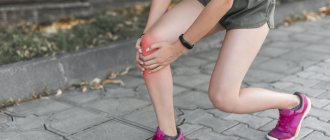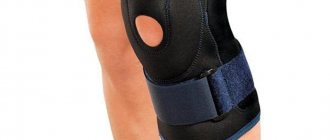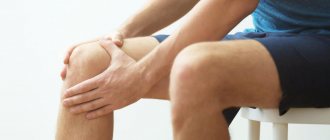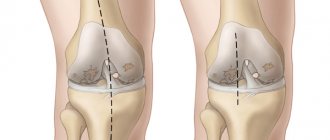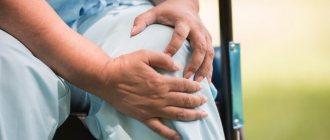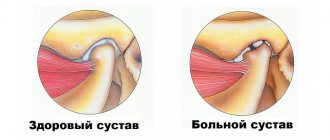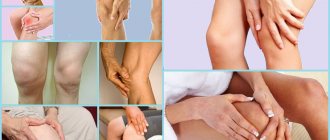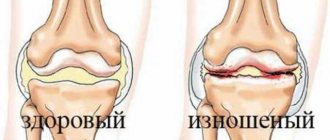Definition and functions of the meniscus Classification of injuries Possible causes of pathology Symptoms of a meniscus tear Degrees of severity of a meniscus tear Diagnosis of a meniscal tear Treatment of a meniscal tear of the knee joint Prevention of a meniscal tear of the knee joint
The knee joint is the most vulnerable part of the human body
, which is exposed to constant trauma and damage in everyday life. One such injury is a torn meniscus of the knee joint.
This closed injury is rarely accompanied by persistent pain.
, and therefore can remain unnoticed for a long time not only by the patient himself, but also by doctors. There are often cases when the victim is simply sent on sick leave with a recommendation not to put any weight on the sore leg.
But a meniscus tear is an insidious disease
, which leads to the development of intra-articular pathologies. It often provokes the appearance of erosions of the joint capsule, arthrosis and other degenerative and inflammatory diseases associated with deterioration of depreciation in the joint.
Young, physically active people between 20 and 40 years old are most susceptible to meniscus injuries, but a tear can occur at any age
. Elderly patients with problem joints are also susceptible to it. Let's figure out how to treat a meniscus tear in young and old people and what complications this condition is fraught with.
A torn meniscus is a common knee injury.
Development mechanism
Development mechanism
Stability, strength, shock absorption of the knee, as well as a fairly high range of motion in it, are provided by cartilages located in the gap between the femoral condyles and the recesses of the tibia. They are paired. There are two menisci – the outer (lateral) and the inner (medial). These cartilages are characterized by a crescent-shaped shape. The wide part is called the body. Narrow areas face anteriorly and posteriorly. These are called the anterior and posterior horns.
The internal cartilage has a more rigid fixation by ligaments, so it is more likely to undergo changes. Violation of integrity is realized due to several basic mechanisms, which include a pronounced bruise, a fall on a bent limb (the cartilage is especially often injured when falling on a hard surface with a sharp edge - a step, a curb), as well as tucking (rotation of the lower leg with a fixed thigh or vice versa) . The damage is primarily localized in the area of the posterior horn, since it has the least strength.
Note to patients: signs of rupture
The patient may complain of pronounced pain symptoms in the knee area during the acute period of the injury. At this moment, it is impossible to make a movement, it hurts to bend the leg, trying to move causes pain. In some cases, swelling and hemarthrosis occur. This state of affairs is unfortunate; treatment of the meniscus by professionals is required.
Diagnostic measures
If no characteristic symptoms are identified, the doctor diagnoses the patient as “Sprained ligaments” or “Bruise of the knee joint.” Diagnosis is effective in the subacute period: this is the second week from the moment of injury. At this point, nonspecific symptoms become less pronounced. In this process, treatment of the meniscus in Moscow involves making a diagnosis based on the determination of local pain in the joint area. Special pain tests and MRI are performed.
Causes
Changes in the structure of the internal cartilage of the knee is a polyetiological process that can develop due to the influence of several provoking factors:
- Trauma leading to the implementation of several pathogenetic mechanisms of changes developing in cartilaginous structures. It usually occurs in fairly young people, as well as in athletes - both professionals and amateurs.
- An acquired decrease in the strength of cartilage, which is observed in older people against the background of the development of degenerative changes resulting from impaired nutrition (trophism) of tissues.
- A hereditary change in the properties of cartilage, determined by a violation of the functional state of genes, while changes in integrity can occur in children against the background of low loads for their age (walking, running, squats).
- Inflammation that develops over a relatively long period of time (several years) and partially affects cartilage. It usually occurs against the background of a chronic infection or autoimmune pathology, in which antibodies are produced to body tissues.
Determining the cause of the pathological condition is necessary for adequate etiotropic therapy aimed at eliminating its effects, as well as to prevent similar injuries in the future.
physical therapy complex
complex of physical therapy
After the basic therapeutic course, restorative procedures and measures are prescribed. They involve special physical training in a physical therapy complex (PT). In this case, the load on the knee increases in stages, and this allows the cartilage structures to adapt to it in order to avoid repeated damage.
Due to the fact that the joint is in a state of functional rest for quite a long time, there is a risk of developing contractures (connective tissue adhesions), so rehabilitation with exercises is necessary to prevent the development of this complication. The duration of the course of such measures depends on the type of treatment performed, as well as on the severity of the damage. Typically it varies over a period of time from several months to six months.
types of meniscal tears
types of meniscal tears
Based on their location, the rupture of the posterior (develops most often), anterior horn and body is distinguished. Based on the main development mechanism and causative factor, the classification includes pathological processes and traumatic injuries.
Which specialist treats a meniscus injury?
A traumatologist treats problems of the musculoskeletal system. But due to the fact that unpleasant symptoms can develop several days after the fall that led to the rupture, not everyone thinks to visit the emergency room. As a last resort, it would not be a mistake to contact a therapist - after an examination, he will determine the problem and give the necessary direction. If there is no clinic with specialized specialists in the city, you will need to visit a surgeon. He will conduct an examination and, if necessary, provide treatment.
Clinic
Symptoms of changes that develop as a result of trauma appear acutely, their intensity is proportional to the degree of impairment. Among them:
- Pain that develops mainly on the inside of the knee and intensifies when trying to carry out active or passive movements in it.
- Restriction of mobility, which can reach a complete block when part of the cartilage is torn off and wedged. Any attempts at movement usually lead to a sharp increase in discomfort.
- Inflammatory manifestations in the form of redness, swelling of soft tissues. They lead to a visually noticeable increase in the knee. There is a local increase in temperature (the knee joint becomes hot to the touch).
In pathological disorders leading to degeneration of internal cartilage, symptoms develop gradually over a fairly long period of time. The pain may be absent at first, then it appears and intensifies with loads on the leg. Movements may be accompanied by characteristic “clicks” and “crunches,” which indicates the development of degenerative processes in cartilage tissue.
Definition and functions of the meniscus
The meniscus is a cartilage pad measuring about 6 cm and about 3-4 mm thick that is present in the knee, shoulder, ankle and some other joints.
This spacer is located inside the joint (between the articular surfaces) and has a C-shape. Each knee has 2 menisci - one on the inside (medial menisci, firmly secured by ligaments) and on the outside (lateral menisci, more mobile). They perform the following functions:
- depreciation
- absorbing shock loads on the joint when running, walking, jumping; - protection of subchondral bones
- the meniscus protects the bones that form the knee joint from the loads associated with upright posture (distributes them evenly over the entire surface of the joint, preventing rapid wear of the protruding parts); - ensuring congruence (coincidence and optimal interaction) of the articular surfaces
- plays the role of a seal in the joint.
Diagnostics
Diagnostics
Before starting adequate treatment, the doctor must prescribe reliable instrumental diagnostics with visualization of the knee structures, including the menisci. In modern medical clinics, it is performed using X-rays, ultrasound, magnetic resonance (MRI) and computed tomography (CT) scans, as well as arthroscopy.
MRI has a high diagnostic value and is used to classify disorders according to Stoller (the classification includes four degrees of severity, determined by certain criteria).
Arthroscopy is an invasive diagnostic method that involves direct examination of structures on a monitor screen by introducing an arthroscope equipped with a video camera with lighting into the joint cavity.
First aid
When a meniscus ruptures, the pain is so severe that the victim cannot put weight on his foot. He needs help getting to bed, laying him down, raising the injured leg by placing a bolster or pillow under his shin. You should not try to straighten a blocked joint, as this can cause even greater damage. It is necessary to fix the joint with a splint, a removable splint, or apply an elastic bandage that does not compress the skin too much.
To relieve inflammatory swelling and eliminate pain, apply an ice pack wrapped in thick cloth to your knee every hour for 10 minutes. Any non-steroidal anti-inflammatory drug (NSAID) can be used as analgesics - Ketorol, Nise, Diclofenac, Nurofen tablets.
Principles of treatment
The main goal of therapeutic measures is to correct disorders of the cartilage of the knee, as well as its functional state. They are complex and aimed at all parts of the pathogenetic mechanism, and may include several areas:
- Conservative (non-surgical) measures.
- Operation.
- Recovery.
The scope of treatment is determined by the treating specialist based on the results of a clinical subjective examination and additional instrumental diagnostics.
Treatment without surgery
If, based on a comprehensive diagnosis, a mild injury to the internal meniscus of the knee joint has been identified, treatment may only include conservative measures without surgery. These include:
- Providing rest, which is achieved through the use of tight bandages with an elastic bandage or the application of a plaster splint.
- Prescription of medications of various groups - anti-inflammatory (glucocorticosteroids or non-steroidal drugs) medications to reduce the intensity of inflammation, chondroprotectors that promote the restoration of cartilage tissue, as well as preventing its further destruction, vitamins to improve the course of metabolic processes.
- Physiotherapeutic procedures, which are of particular importance in the gradual chronic development of disorders. They include magnetic therapy, electrophoresis with medications, ozokerite.
A set of conservative treatment measures allows one to achieve a good therapeutic effect and avoid surgery, but only in the case of incomplete rupture of the internal cartilage.
Operation
If there is a complete tear that involves the entire medial meniscus of the knee, treatment usually involves surgery. Its main purpose is plastic surgery of altered structures or removal of part of the cartilage if it cannot be restored. Modern surgery is performed using 2 main methods:
Control of cure
If conservative treatment was prescribed, a return to normal functioning of the knee will require at least a month. The doctor monitors the healing process of damaged tissues using systematic ultrasound examinations. The rehabilitation period after surgery depends on the severity of the operation.
Typically, arthroscopy requires three times less healing time than open surgery. An orthopedist-traumatologist prescribes instrumental diagnostic methods on an individual basis. After rehabilitation, it is necessary to periodically visit a doctor to assess the condition of the joint.
Arthroscopic technique
Arthroscopic technique
Thanks to the introduction of arthroscopic surgery into clinical practice, it was possible to achieve a significant reduction in the morbidity of surgical treatment and reduce the length of time required for:
- tissue regeneration and restoration of mobility;
- the entire course of treatment and a person’s stay in a medical institution.
Postoperative recovery
After surgical procedures, regardless of the method of their implementation, the patient remains in the hospital of a medical institution for a certain period of time. A set of measures is prescribed aimed at speedy tissue regeneration of the postoperative wound area and prevention of complications:
- Limitation of leg mobility.
- Periodic treatment of surgical suture materials with special antiseptics, which are usually used in the form of a solution.
- Prescribing antibacterial agents to prevent infection.
- The use of hemostatic medications to prevent bleeding, especially after open surgery.
The average postoperative period is determined by the method of performing the operation. It varies from 3-5 to 10 days.
Conservative therapy
To eliminate the inflammatory process and to prevent the disease from becoming chronic, it is necessary to take treatment measures in a timely manner and comply with them for the prescribed period.
In some cases, when the meniscus has been slightly damaged, a course is prescribed that allows you to quickly get back on your feet and restore mobility to the joint. This course includes taking anti-inflammatory medications, which are taken orally or rubbed into the knee in the form of gels and ointments.
In addition, when there is a significant improvement in the condition and tests show that there is no longer inflammation, the treatment does not end there. A long period of rest greatly weakens the muscles, and it is necessary to restore their tone, as well as develop the joint. To do this, the patient must attend physiotherapy procedures that improve blood circulation in the affected area and metabolism. Thus, food products containing useful and strengthening elements bring more benefits, and these same vitamins are absorbed better and faster.
Therapeutic gymnastics is a separate point in the course of human treatment. This is a set of exercises that is prescribed for each case individually and requires responsibility from the patient himself. At first, the exercises do not carry much load, so as not to damage the joint. For example, a patient can simply move a foot or hip, and at the same time improve blood flow and maintain muscle tone. Then the complex becomes more complex, requiring movement in the joint itself. Training is carried out lying or sitting. At the final stage of treatment, full loads are recommended.
Rehabilitation
Rehabilitation
Carrying out rehabilitation measures is no less important than the main course of treatment. It involves resting the knee immediately after surgery or conservative therapy, followed by special activities that involve certain movements.
As the tissues recover, the range of motion and load gradually increase. This makes it possible for the cartilage tissue to adapt to loads and subsequently restore the functional state of the knee.
Severity of meniscus injury
Before prescribing a course of treatment, the doctor must determine the severity of the injury. This is due to the fact that minor injuries do not require hospitalization or surgery. There are three degrees of severity of rupture:
- The pain is moderate, swelling is not obvious.
- The pain is severe, but its severity dulls over time, swelling is pronounced, and a hematoma is present.
- Acute pain, extensive swelling, hematoma, impossible to step on the affected leg.
Regardless of the extent of the rupture, the affected joint must be shown to a doctor. This is because improper healing of cartilage tissue can reduce the functionality of the knee joint and lead to lameness.
Treatment at home
Carrying out therapeutic measures at home is only possible if non-surgical treatment is prescribed. If there is a need for parenteral (intramuscular, subcutaneous or intravenous) administration of drugs, the patient receives treatment on an outpatient basis. To do this, he visits the manipulation room of a medical institution, where he undergoes the necessary manipulations.
An attempt to independently treat damage to the internal cartilage without undergoing the necessary set of diagnostic tests can cause the development of various complications, including pinching of part of the damaged meniscus with its wedging into the joint space. Such complications lead to the need for subsequent surgery.
Physiotherapeutic procedures
Physiotherapy involves the use of various physical factors that reduce the severity of inflammatory, degenerative-dystrophic processes, and also promote faster tissue restoration. For this, depending on the severity of the pathological process and the technical capabilities of the medical institution, the following can be used:
- ozokerite;
- mud baths;
- electrophoresis with various anti-inflammatory drugs.
The duration of use of physiotherapeutic procedures is determined individually by a medical specialist. They are usually combined with drug treatment.
